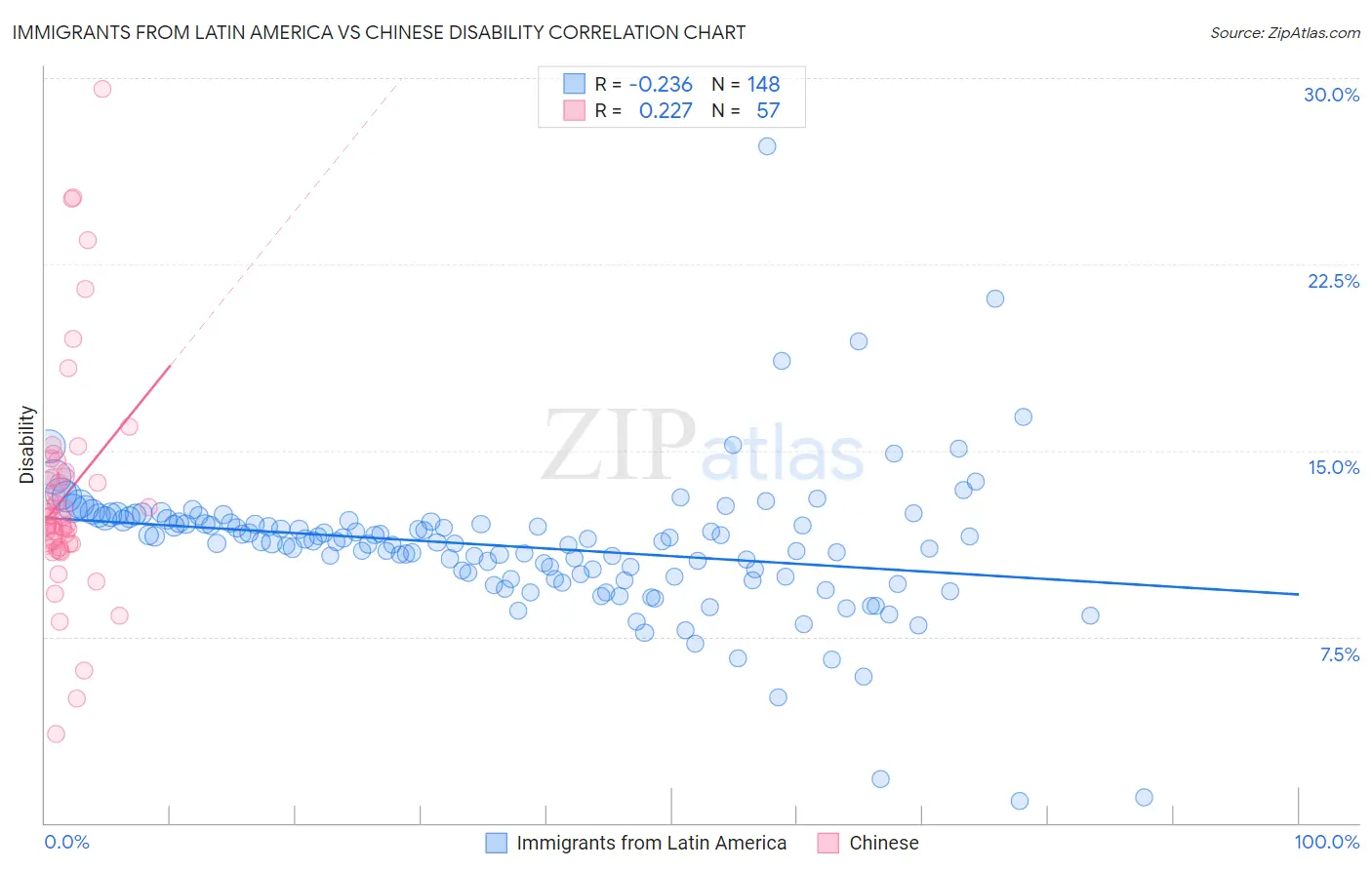Immigrants from Latin America vs Chinese Disability
COMPARE
Immigrants from Latin America
Chinese
Disability
Disability Comparison
Immigrants from Latin America
Chinese
11.7%
DISABILITY
54.1/ 100
METRIC RATING
168th/ 347
METRIC RANK
12.2%
DISABILITY
2.0/ 100
METRIC RATING
236th/ 347
METRIC RANK
Immigrants from Latin America vs Chinese Disability Correlation Chart
The statistical analysis conducted on geographies consisting of 558,476,645 people shows a weak negative correlation between the proportion of Immigrants from Latin America and percentage of population with a disability in the United States with a correlation coefficient (R) of -0.236 and weighted average of 11.7%. Similarly, the statistical analysis conducted on geographies consisting of 64,802,035 people shows a weak positive correlation between the proportion of Chinese and percentage of population with a disability in the United States with a correlation coefficient (R) of 0.227 and weighted average of 12.2%, a difference of 4.5%.

Disability Correlation Summary
| Measurement | Immigrants from Latin America | Chinese |
| Minimum | 0.89% | 3.6% |
| Maximum | 27.3% | 29.6% |
| Range | 26.4% | 26.0% |
| Mean | 11.1% | 13.2% |
| Median | 11.3% | 12.3% |
| Interquartile 25% (IQ1) | 9.9% | 11.2% |
| Interquartile 75% (IQ3) | 12.1% | 14.0% |
| Interquartile Range (IQR) | 2.2% | 2.8% |
| Standard Deviation (Sample) | 2.9% | 4.6% |
| Standard Deviation (Population) | 2.9% | 4.6% |
Similar Demographics by Disability
Demographics Similar to Immigrants from Latin America by Disability
In terms of disability, the demographic groups most similar to Immigrants from Latin America are Estonian (11.7%, a difference of 0.020%), Pakistani (11.7%, a difference of 0.030%), Immigrants from Austria (11.7%, a difference of 0.030%), Immigrants from Albania (11.7%, a difference of 0.060%), and Immigrants from Southern Europe (11.7%, a difference of 0.060%).
| Demographics | Rating | Rank | Disability |
| Immigrants | Cuba | 62.8 /100 | #161 | Good 11.6% |
| Immigrants | Haiti | 59.2 /100 | #162 | Average 11.7% |
| Immigrants | Trinidad and Tobago | 58.9 /100 | #163 | Average 11.7% |
| Syrians | 58.5 /100 | #164 | Average 11.7% |
| Cubans | 56.7 /100 | #165 | Average 11.7% |
| Pakistanis | 54.7 /100 | #166 | Average 11.7% |
| Estonians | 54.4 /100 | #167 | Average 11.7% |
| Immigrants | Latin America | 54.1 /100 | #168 | Average 11.7% |
| Immigrants | Austria | 53.4 /100 | #169 | Average 11.7% |
| Immigrants | Albania | 52.8 /100 | #170 | Average 11.7% |
| Immigrants | Southern Europe | 52.8 /100 | #171 | Average 11.7% |
| Trinidadians and Tobagonians | 52.7 /100 | #172 | Average 11.7% |
| Maltese | 50.6 /100 | #173 | Average 11.7% |
| Albanians | 50.0 /100 | #174 | Average 11.7% |
| Haitians | 48.6 /100 | #175 | Average 11.7% |
Demographics Similar to Chinese by Disability
In terms of disability, the demographic groups most similar to Chinese are Immigrants from Congo (12.2%, a difference of 0.050%), Yup'ik (12.2%, a difference of 0.090%), Norwegian (12.2%, a difference of 0.090%), Japanese (12.2%, a difference of 0.13%), and Swedish (12.2%, a difference of 0.13%).
| Demographics | Rating | Rank | Disability |
| Inupiat | 2.8 /100 | #229 | Tragic 12.2% |
| Samoans | 2.6 /100 | #230 | Tragic 12.2% |
| Malaysians | 2.5 /100 | #231 | Tragic 12.2% |
| Italians | 2.5 /100 | #232 | Tragic 12.2% |
| Bahamians | 2.3 /100 | #233 | Tragic 12.2% |
| Japanese | 2.3 /100 | #234 | Tragic 12.2% |
| Yup'ik | 2.2 /100 | #235 | Tragic 12.2% |
| Chinese | 2.0 /100 | #236 | Tragic 12.2% |
| Immigrants | Congo | 1.9 /100 | #237 | Tragic 12.2% |
| Norwegians | 1.9 /100 | #238 | Tragic 12.2% |
| Swedes | 1.8 /100 | #239 | Tragic 12.2% |
| Hungarians | 1.7 /100 | #240 | Tragic 12.2% |
| Yugoslavians | 1.7 /100 | #241 | Tragic 12.2% |
| Poles | 1.7 /100 | #242 | Tragic 12.2% |
| British | 1.5 /100 | #243 | Tragic 12.2% |